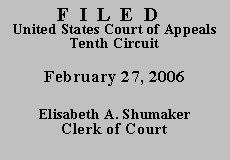

|
UNITED STATES OF AMERICA, |
|
Before MURPHY, SEYMOUR and McCONNELL, Circuit Judges.
On appeal, Canedo asserts the district court erred in recharacterizing his motion as a second or successive § 2255 motion. In particular, Canedo asserts the district court recharacterized his motion solely on the basis of this court's decision in Lopez v. Douglas, 141 F.3d 974 (10th Cir. 1998), and that Lopez is no longer good law in the wake of the Supreme Court's decision in Gonzales v. Crosby, 125 S. Ct. 2641 (2005).
In Lopez, this court set out the following categorical rule: a Rule 60(b) motion seeking to vacate a prior judgment denying a § 2254 petition was a second or successive habeas petition subject to the preauthorization provisions of the AEDPA. Lopez, 141 F.3d at 975-76. The district court lacked jurisdiction to decide such motions on the merits unless the petitioner first obtained authorization from this court to file the habeas petition in district court. Id. In Gonzalez, however, the Supreme Court rejected the categorical approach embodied in Lopez and, instead, adopted a nuanced approach to the question whether any particular Rule 60(b) motion seeking to vacate a prior denial of habeas relief is a second or successive habeas corpus petition. Gonzalez, 125 S. Ct. 2651. Under the rule set out in Gonzalez, a Rule 60(b) motion seeking to raise what would traditionally be considered a claim for habeas relief is a second or successive habeas petition. Id. at 2647-48. When, however, "a Rule 60(b) motion attacks, not the substance of the federal court's resolution of a claim on the merits, but some defect in the integrity of the federal habeas proceedings," the motion is not successive and is not subject to the screening requirements set out in 28 U.S.C. § 2244. Gonzalez, 125 S. Ct. at 2648.
Canedo is wrong in asserting the district court recharacterized his motion as a second or successive § 2255 motion on the basis of Lopez. Although the district court did cite to Lopez, it did so solely for the unremarkable proposition that "Rule 60(b) 'cannot be used to circumvent [the statutory] restraints on successive habeas petitions.'" Dist. Court Order at 3 (quoting Lopez, 141 F.3d at 975). In deciding that Canedo's Rule 60(b) motion was, in reality, a second or successive § 2255 motion, the district court relied exclusively on Gonzalez. As noted by the district court, Canedo's motion asserted his conviction was invalid under Crawford because it was based on hearsay improperly admitted at trial and that his sentence was invalid because it was based, in part, on judicial fact-finding in violation of Booker. Canedo contended below and continues to contend on appeal, that his Crawford and Booker claims merely attacked the integrity of his trial. As the district court quite correctly noted, however, Canedo's motion asserted an entitlement to relief from his conviction on the basis of a change in the substantive law regarding the admission of hearsay at trial and from his sentence based on the propriety of judicial fact-finding at sentencing under the regime set out in the United States Sentencing Guidelines. In Gonzalez, the Supreme Court concluded that such claims were habeas claims not properly brought in a 60(b) motion:
a motion might contend that a subsequent change in substantive law is a "reason justifying relief," Fed. Rule Civ. Proc. 60(b)(6), from the previous denial of a claim. E.g., Dunlap v. Litscher, 301 F.3d 873, 876 (C.A.7 2002). Virtually every Court of Appeals to consider the question has held that such a pleading, although labeled a Rule 60(b) motion, is in substance a successive habeas petition and should be treated accordingly. E.g., Dunlap, supra, at 876.
We think those holdings are correct. . . . [A] Rule 60(b) motion based on a purported change in the substantive law governing the claim could be used to circumvent § 2244(b)(2)(A)'s dictate that the only new law on which a successive petition may rely is "a new rule of constitutional law, made retroactive to cases on collateral review by the Supreme Court, that was previously unavailable." In addition to the substantive conflict with AEDPA standards, . . . use of Rule 60(b) [in such a circumstance] would impermissibly circumvent the requirement that a successive habeas petition be precertified by the court of appeals as falling within an exception to the successive-petition bar. § 2244(b)(3).
Gonzalez, 125 S. Ct. at 2647.
Despite Canedo's protestations to the contrary, his motion asserted that his previous § 2255 motion was wrongly decided on the merits based on the Supreme Court's subsequent decision in Crawford and Booker. As Gonzalez makes clear, these are habeas claims not properly brought in a Rule 60(b) motion. Instead, before bringing such claims, Canedo must obtain precertification from this court pursuant to the terms of § 2255 para. 8. Accordingly, the district court's dismissal of Canedo's motion for lack is jurisdiction is hereby AFFIRMED.
Alternatively, treating Canedo's appellate filings as an implied request to file a second or successive § 2255 motion, we DENY the request because the Supreme Court has not made either Crawford or Booker retroactive to cases on collateral appeal. Cf. Brown v. Uphoff, 381 F.3d 1219, 1227 (10th Cir. 2004) (holding that Crawford is not retroactively applicable to an initial habeas petition); United States v. Bellamy, 411 F.3d 1182, 1186 (10th Cir. 2005) (holding that Booker does not apply retroactively to initial habeas petitions).
ENTERED FOR THE COURT
Michael R. Murphy
Circuit Judge
*. This order and judgment is not binding precedent, except under the doctrines of law of the case, res judicata and collateral estoppel. The court generally disfavors the citation of orders and judgments; nevertheless, an order and judgment may be cited under the terms and conditions of 10th Cir. R. 36.3.